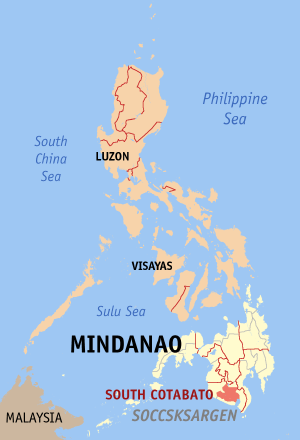South Cotabato
| Province of South Cotabato | |
Provincial seal of South Cotabato |
|
 Map of the Philippines with South Cotabato highlighted |
|
| Region | SOCCSKSARGEN (Region XII) |
| Capital | Koronadal City |
| Divisions | |
| - Highly urbanized cities | 1 |
| - Component cities | 1 |
| - Municipalities | 10 |
| - Barangays | 224 |
| - Congressional districts | 2 |
| Population | 21st largest |
| - Total (2007) | 1,102,550 |
| - Density | 246 /km² (637 /sq mi) (30th highest) |
| Area | 26th largest |
| - Total | 4,489 km2 (1,733 sq mi) |
| Founded | |
| Spoken languages | Hiligaynon, Cebuano |
| Governor | Daisy Avance-Fuentes (KAMPI) |
South Cotabato is a province of the Philippines located in the SOCCSKSARGEN region in Mindanao. Its capital is Koronadal City and borders Sultan Kudarat to the north and west, Sarangani to the south and east, and Davao del Sur to the east. To the southeast lies Sarangani Bay.
General Santos City, on the shores of Sarangani Bay, is the largest and most important city of South Cotabato, and is a major seaport. The province of Sarangani used to be part of South Cotabato until it was made an independent province in 1992.
Contents |
People and culture
Official song
"South Cotabato March"
- This is the land of South Cotabato/ a place on earth that all should know/ the hopes and joys of all with love aglow/ between the hearts of high and low...
- The Mt. Matutum towering high/ that seems to reach the bright blue sky/ prosperity doth signify/ the hearts and emblems to passersby...
- Beautiful province South Cotabato/ the land and seas that all should know/ beautiful towns are all around you/ and gleaming streams of Lake Sebu...
- The busy trade in Sarangani/ do all bespeak of prosperity/wonderful land of long ago/awaits a love for life anew...
Language
The people of South Cotabato are multilingual, able to communicate in Hiligaynon, Cebuano, Tagalog and English. The indigenous tribes, in addition, use their own tribal dialects. A situation wherein several people, each speaking solely in his own dialect and are still able to communicate with the others, is not unheard of.
People
The people of South Cotabato have diverse heritages. Ilonggos from Panay and Negros in the Visayas settled the municipalities of Norala, Banga, Surallah, Sto. Niño and the province's capital, Koronadal, and the Visayan languages Hiligaynon and Kiniray-a are the province's major communication media. On the other hand, people from the Ilocano speaking regions of Luzon settled in Tampakan, Tantangan and Tupi, and the Ilocano language may still be heard spoken in these towns. The Visayan language Cebuano is also the main language of the municipality of Polomolok and is one of the main languages of Tupi (along with Ilonggo and Tagalog, which slightly differs from Manila Tagalog). Both towns are near to Cebuano-speaking General Santos City.
The Maguindanao tribe is the major Muslim Filipino tribe in the province. Although many of them still wear their traditional costumes and practice their native customs, others have come to adapt the more liberal practices of their Christian neighbors such as wearing shorts and sleeveless shirts, eschewing the use of the headscarf, and attending dances/mixed gatherings. Other indigenous Filipino tribes are the T'boli and B'laan tribes in Lake Sebu and T'boli municipalities, famous for their brassworks, beadwork and t'nalak weave. The people of these tribes wear colorful embroidered native costumes and beadwork accessories. The women of these tribes, particularly, wear heavy brass belts with brass 'tassels' ending in tiny brass bells that herald their approach even when they are a long way off.
The people of South Cotabato still retain many of the practices and traditions of their particular tribal heritages, although infused with a flavor that is distinctly Mindanaoan and the product of cultural interaction between the immigrants and the indigenous peoples of the area. One vivid example of this is the predominant use of the native 'malong', the colorful, tubelike garment used as a skirt by the indigenous tribes, in place of a blanket or sleeping bag.
Government
Elected Officials 2007-present
*Gov. Daisy Avance-Fuentes
*Vice Gov. Eliordo Ogena
-
- 1st District w/ Gen. Santos City Rep. Darlene Antonino-Custodio
- 2nd District w/ Koronadal City Rep. Arthur Pingoy
Geography
Political
South Cotabato is subdivided into 10 municipalities and 2 cities.
Cities
- General Santos City (Dadiangas)
- Koronadal City
Municipalities
|
|
Tourism
Tourist attractions in South Cotabato include Lake Sebu, Mt. Matutum, and Koronadal Valley and the beautiful surroundings of pao-pao.
Musical Heritage
The native Maguindanaon of South Cotabato have a fascinating culture that revolves around kulintang music, a specific type of gong music, found among both Muslim and non-Muslim groups of the Southern Philippines.
References
|
|||||||||||